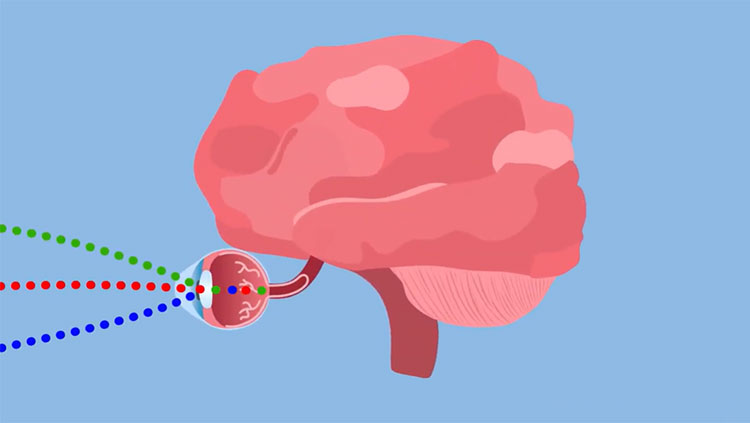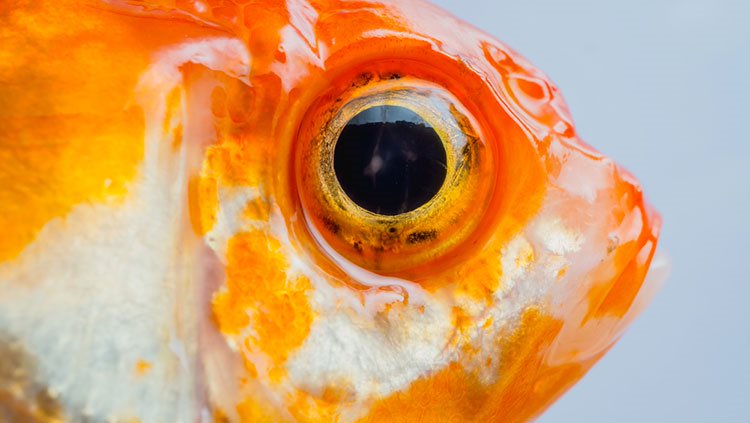Baby Mantis Shrimp Perceive UV Light Like Their Parents
- Published6 Sep 2022
- Author Ravindra Palavalli Nettimi
- Source BrainFacts/SfN

There is more to mantis shrimp than meets the eye. They pack a punch, decimating their prey using deadly strikes. And they can dazzle the world with their cute googly eyes.
The world looks colorful to our eyes with only three color receptors — red, green, and blue. But for a mantis shrimp, a small marine crustacean with 12 color receptors, it looks quite vibrant. Adult mantis shrimp’s sophisticated eyes on stalks perceive visible, ultraviolet (UV), and also polarized light — useful for their mating and territorial behaviors. Their visual abilities have even inspired imaging technology to detect cancer. Impressive for a 10 cm long crustacean.
But in their tiny (~0.3 cm) larval form, mantis shrimp are transparent with simpler eyes. Turns out, the ‘simpler’ larval eyes are more like adult eyes than scientists had expected. These tiny larvae can detect UV light, too, according to a study in the Journal of Experimental Biology.
To test UV vision in live mantis shrimp larvae, scientists from the University of Hawai'i at Mānoa and the University of Delaware shined flashes of UV light on their eyes. Photoreceptors, the light-detecting cells in their retina, responded to the UV light. The scientists then checked whether the larvae expressed UV opsin genes. Opsins proteins capture light and in turn help send electrical signals to the brain.
Researchers found the larvae expressed the same three UV opsins also found in adult mantis shrimp. This confirmed UV vision in mantis shrimp larvae: tiny larval eyes with a mighty vision.
Why the larvae need UV vision is a mystery, as studying the transparent animals in their natural habitat is challenging. Scientists speculate it could help them during foraging. The larvae likely swim on the ocean’s surface at night and may move into deeper water during the day. During dawn and dusk, the skylight has more UV light against the open water background. So, larvae may use UV vision to detect smaller transparent prey on the ocean’s surface. Though larval mantis shrimp behavior remains elusive, their ultraviolet vision highlights the extraordinary visual adaptations of miniature marine creatures.
CONTENT PROVIDED BY
BrainFacts/SfN
References
Congdon, O. (n.d.). How is a mantis shrimp’s vision like a satellite? Australian Academy of Science. https://www.science.org.au/curious/earth-environment/all-eyes-reef
Cronin, T.W., Chiou, T., Caldwell, R.L., Roberts, N., Marshall, J. (2009) "Polarization signals in mantis shrimps" Polarization Science and Remote Sensing IV, Proc. SPIE 7461, 74610C. https://doi.org/10.1117/12.828492
McDonald, M. S., Palecanda, S., Cohen, J. H., & Porter, M. L. (2022). Ultraviolet vision in larval Neogonodactylus oerstedii. Journal of Experimental Biology, jeb.243256. https://doi.org/10.1242/jeb.243256
Patek, S. N., Korff, W. L., & Caldwell, R. L. (2004). Deadly strike mechanism of a mantis shrimp. Nature, 428(6985), 819–820. https://doi.org/10.1038/428819a
Rigby, S. (2021). What is polarised light? BBC Science Focus. https://www.sciencefocus.com/science/what-is-polarised-light/
Shichida, Y., & Matsuyama, T. (2009). Evolution of opsins and phototransduction. Philosophical Transactions of the Royal Society B: Biological Sciences, 364(1531), 2881–2895. https://doi.org/10.1098/rstb.2009.0051
Thomas W. Cronin, Tsyr-Huei Chiou, Roy L. Caldwell, Nicholas Roberts, & Justin Marshall. (2009). Polarization signals in mantis shrimps. 7461, 74610C. https://doi.org/10.1117/12.828492


















